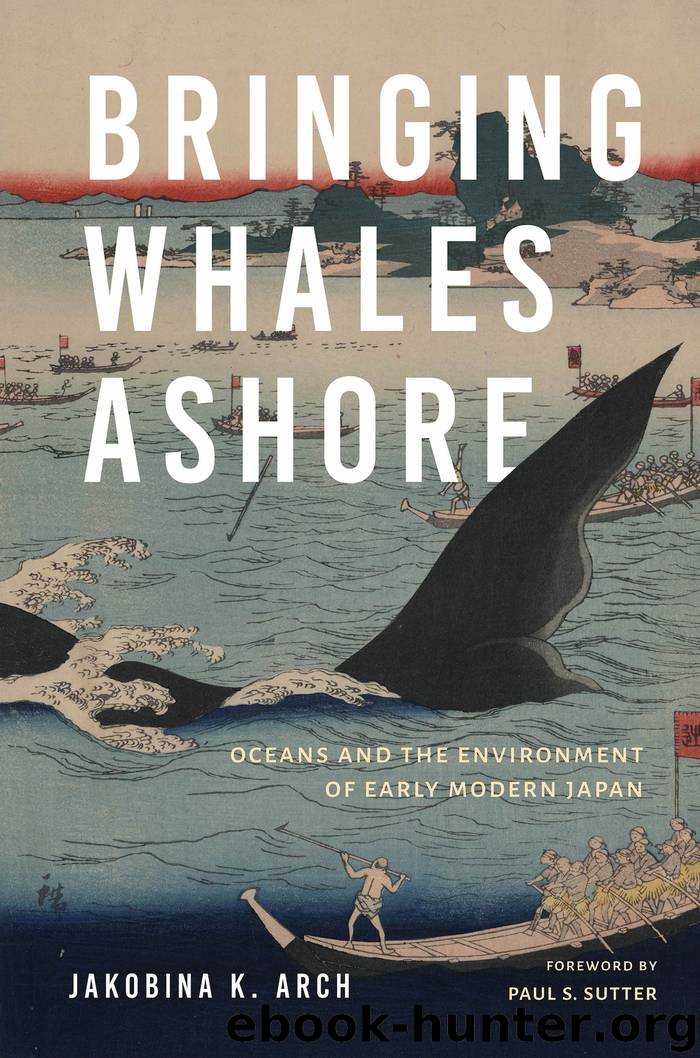Bringing Whales Ashore by Arch Jakobina K

Author:Arch, Jakobina K.
Language: eng
Format: epub
Publisher: University of Washington Press
Published: 2018-03-18T16:00:00+00:00
EXPLAINING WHALES: DESCRIPTIONS OF WHALERS AND THEIR PREY
Judging from the number of texts describing whaling groups that still exist today, many people were just as curious about the whaling groups who conquered whales as they were about the whales themselves. Descriptions of the process of capturing whales and of the different villages that practiced organized whaling provided another vector for whale-related information that made the marine environment more relevant to people who did not live in whaling or fishing villages. Two of the most famous and comprehensive works about whales from the nineteenth century, “Geishikō” (1808) and Isanatori ekotoba (1832), combined natural history information, including anatomical and classificatory images of whale species, with details about the process of capturing whales. Both of these works show how different types of information about whales intersected and spread beyond whaling areas themselves, and how it is not possible to break information from the period down into neatly isolated boxes based on specializations that exist today (e.g., science, pop culture, art, etc.). Given the broad interests of most scholars, as whales drove unique representations of anatomy and forced a rethinking of the materia medica–based classification system, we should expect to see scholars thinking about whales from other perspectives as well. The process of writing “Geishikō” is a particularly good illustration of how networking between scholars with different training brought curiosity about whales and whalers into all kinds of conversations.
“Geishikō” describes whaling based on book research and also the author’s interviews of people involved in Hirado domain’s Ikitsukishima whaling group (map 2). The author, Confucian scholar Ōtsuki Heisen, had no real connection to the whalers there before he stopped by to collect information about whaling for his cousin, doctor and Dutch studies scholar Ōtsuki Gentaku. Gentaku’s interest had been sparked by conversations with a patient of his in Edo who happened to be the former leader of the Masutomi whaling group. Thus, the manuscript shows the kinds of information that an interested outsider who was also a scholar might want to know about the process and context for the whaling industry in the early nineteenth century. It also provides an interesting comparison to the kinds of information circulating from earlier trips like Genjō and Matsugen’s, whose original writing and illustration do not survive. “Geishikō” remained as a manuscript and was never published, but like many manuscripts in the period, it did circulate in hand-copied form, and some of its information and illustrations were clearly used in the production of Isanatori ekotoba.38
Because of Gentaku’s ties to Dutch studies, “Geishikō” is based on both Japanese and Dutch sources.39 The text is divided into six volumes, of which the first three focus on what we would consider today to be scientific information, including whale names and classifications, as well as skeleton and internal organ diagrams. The last three sections contain information about the process of whaling rather than about whales themselves. The anatomical diagrams are of a very different type from the anatomical whale in scrolls like “Diagram of six whales.
Download
This site does not store any files on its server. We only index and link to content provided by other sites. Please contact the content providers to delete copyright contents if any and email us, we'll remove relevant links or contents immediately.
| Fisheries & Aquaculture | Forests & Forestry |
The Lonely City by Olivia Laing(4112)
Animal Frequency by Melissa Alvarez(3750)
All Creatures Great and Small by James Herriot(3506)
Walking by Henry David Thoreau(3227)
Exit West by Mohsin Hamid(3173)
Origin Story: A Big History of Everything by David Christian(3133)
COSMOS by Carl Sagan(2944)
How to Read Water: Clues and Patterns from Puddles to the Sea (Natural Navigation) by Tristan Gooley(2849)
Hedgerow by John Wright(2771)
The Inner Life of Animals by Peter Wohlleben(2763)
Origin Story by David Christian(2677)
How to Read Nature by Tristan Gooley(2657)
Project Animal Farm: An Accidental Journey into the Secret World of Farming and the Truth About Our Food by Sonia Faruqi(2655)
How to Do Nothing by Jenny Odell(2640)
A Forest Journey by John Perlin(2584)
Water by Ian Miller(2579)
The Plant Messiah by Carlos Magdalena(2451)
A Wilder Time by William E. Glassley(2358)
Forests: A Very Short Introduction by Jaboury Ghazoul(2331)
